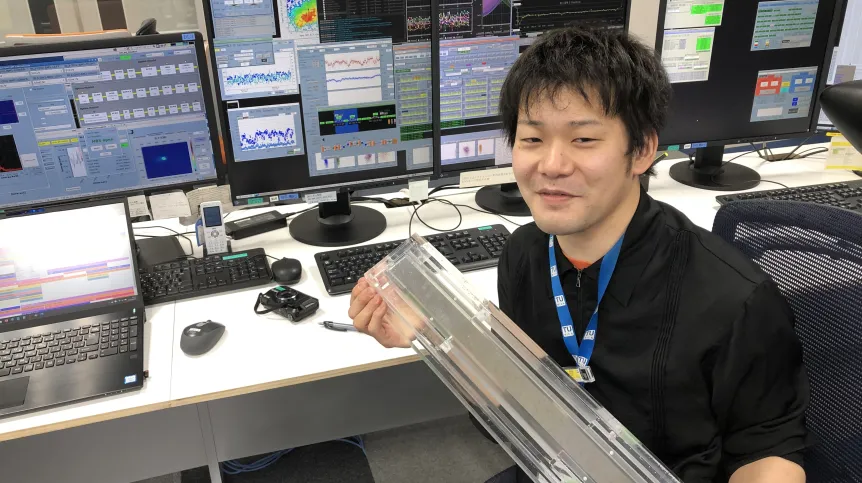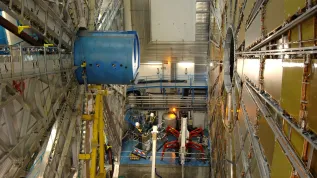
X-ray laser pulses can be used to study the structure of matter with unprecedented accuracy, but the pulses destroy the sample. Physicists from the Polish-Japanese team believe that with sufficiently short laser pulses, it will be possible to view an undisturbed structure of matter. They have demonstrated that atoms of certain crystal react to an avalanche of photons with a delay.
Representatives of the Institute of Nuclear Physics of the Polish Academy of Sciences in Kraków informed about the research project.
Is it possible to see chemical reactions of complex molecules at subatomic resolution? It seems so, but only with the use of free electron lasers (FEL). Lasers of this type are capable of generating X-ray pulses that not only are ultra-short, measured in femtoseconds (i.e. millionths of a billionth of a second!), but also contain huge amounts of photons. After irradiating a sample with such a pulse, a diffraction image is produced, which physicists can use to attempt to reconstruct the spatial structure of molecules. This approach, however, has a very serious drawback...
“When we irradiate a sample with lots of high-energy photons, its atoms begin to interact with the radiation so strongly that the material is destroyed. What do we see in the recorded diffraction images - is it the true structure of the sample, or rather an image of its destruction?” asks Professor Beata Ziaja-Motyka from the Institute of Nuclear Physics of the Polish Academy of Sciences in Kraków and the Centre for Free-Electron Laser Research (CFEL) at DESY in Hamburg.
Professor Ziaja-Motyka is a member of an international team of physicists led by Dr. Ichiro Inoue of Japan's RIKEN SPring-8 Center FEL facility. In their latest paper published in the prestigious physics journal Physical Review Letters, the scientists present the results of work on such processes for corundum nanocrystals made up of oxygen and aluminium atoms.
The experimental part was carried out using the SACLA X-ray laser operating in Hyogo, Japan.
Dr. Inoue said: “In our research with corundum nanocrystals, we used pulses lasting just six femtoseconds. The data collected allowed us to estimate that the crystal atoms start to react to the photon beam with a delay of 20 femtoseconds.”
Professor Beata Ziaja-Motyka added: “The experimental results are perfectly consistent with the predictions of our models and simulations, where a similar delay also appears.”
He colleague Dr. Victor Tkachenko (Institute of Nuclear Physics PAS) who was also involved in the theoretical description and simulations of the studied phenomena said: “We believe that the main reason for this delay is the fact that the electrons located in atoms trapped in the nodes of the crystal lattice act a bit like a bumper and are the first to pick up the impetus of the X-ray pulse.”
The delayed response of oxygen and aluminium atoms in corundum to the X-ray pulse turns out to be a consequence of the following course of events. When high energy photons enter the crystal, they transmit this energy mainly to the electrons in the atoms embedded in the nodes of the crystal lattice.
As a result of this interaction, electrons are massively knocked out of the atoms. Due to the significant mass difference between the released electrons and the ionising atoms, the latter do not initially feel the recoil.
However, the atoms themselves, hitherto electrically inert, become strongly electrically charged and begin to feel repulsion from their similarly charged neighbours. It is this process that takes about 20 femtoseconds. At an even later stage, the ions gain additional energy through interactions with the accelerated electrons. The ultimate result is the destruction of the sample.
Systems made up of atoms of different elements have already been studied with X-ray FEL lasers. However, pulses with durations of 15-20 femtoseconds were used to irradiate them. It is now known that this is long enough for atoms in the systems to begin to respond to pulse irradiation. This means that the previously obtained images represented structures already partially disturbed by interaction with the laser beam.
The consistency of the reaction times of atoms in the corundum nanocrystal to an X-ray pulse, measured in the latest experiment, with times predicted by simulations, allows to optimistically consider further attempts to observe other, more complex systems, especially those containing light elements that are the building blocks of living matter.
The structure of simple nanocrystals, such as corundum, is reproducible. Existing symmetries facilitate making observations, analysing diffraction images and simulating the reactions of samples to laser pulses.
But many interesting structures are devoid of symmetry. The long-term goal of the work of the Polish-Japanese team of physicists is therefore to develop methods and create tools that enable imaging and simulation of biologically relevant systems, such as protein conglomerates or individual viruses.
The participation of Polish physicists in this research project was possible thanks to a grant from the Polish National Academic Exchange Agency and an agreement between the Institute of Nuclear Physics PAS and the European XFEL centre in Hamburg, the organisation that manages the European free-electron laser.
PAP - Science in Poland
lt/ zan/ kap/
tr. RL













